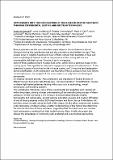Por favor, use este identificador para citar o enlazar a este item:
http://hdl.handle.net/10261/259657COMPARTIR / EXPORTAR:
 SHARE
BASE SHARE
BASE
|
|
| Visualizar otros formatos: MARC | Dublin Core | RDF | ORE | MODS | METS | DIDL | DATACITE | |

| Título: | New insights into the manufacture of high-leaded bronze palstaves through experimental casting and neutron techniques |
Autor: | Armada, Xosé-Lois CSIC ORCID ; Arcidiacono, Laura; Comendador Rey, Beatriz; Faro, María G.; Lackinger, Aaron; Martinón-Torres, Marcos; Silva Sánchez, Noemí CSIC ORCID; Sureda, Pau CSIC ORCID | Palabras clave: | Archaeometallurgy Casting technology Experimental Archaeology Neutron techniques Atlantic Europe Late Bronze and Early Iron Ages |
Fecha de publicación: | sep-2021 | Citación: | 27th Annual Meeting of the European Association of Archaeologists (2021) | Resumen: | Bronze palstaves are the most abundant metal object in the northwestern Iberian Peninsula during the Late Bronze Age and the transition to the Earliest Iron Age. They usually occur in isolated hoards and many of them contain high quantities of lead and have morphological features (such as the presence of the casting jet) that are incompatible with their use as ‘functional’ tools or weapons. Some of these palstaves have massive lead cores, which show a spherical shape in the casting sprue. Two hypotheses have been suggested to explain this phenomenon: 1) the intentional casting of pure lead inside a bronze casing; and 2) massive lead segregation during solidification. As the production and hoarding of these palstaves may have strong social implications, the analysis of this issue matters not only from a technological perspective. An ongoing research project, “Mass production and deposition of leaded bronzes in Atlantic Europe during the Late Bronze Age - Iron Age transition” (ATLANTAXES), focuses on these high-leaded palstaves dealing with issues such as technology, metal provenance and hoarding patterns. This contribution introduces some of the experimental and analytical work carried out within the project, aiming a better understanding of the manufacturing process of these palstaves. On the one hand, a non-invasive characterisation through neutron tomography and radiography, prompt gamma activation analysis and neutron diffraction of one of these palstaves at the ISIS Pulsed Neutron and Muon Source (Oxfordshire, UK) provides unique insights about the bulk of this object. On the other, experimental casting under laboratory conditions allows a better understanding of the factors that determine the internal structure of these palstaves, suggesting that their lead cores are massive lead segregations resulting from high-leaded ternary alloys. Finally, the paper also discuss the advantages of combining such analytical and experimental approaches. | Descripción: | Trabajo presentado en 27th Annual Meeting of the European Association of Archaeologists (EAA), celebrada en Kiel del 6 al 11 de septiembre de 2021. | URI: | http://hdl.handle.net/10261/259657 |
| Aparece en las colecciones: | (INCIPIT) Comunicaciones congresos |
Ficheros en este ítem:
| Fichero | Descripción | Tamaño | Formato | |
|---|---|---|---|---|
| bronze_palstaves.pdf | 1,24 MB | Adobe PDF |  Visualizar/Abrir |
CORE Recommender
NOTA: Los ítems de Digital.CSIC están protegidos por copyright, con todos los derechos reservados, a menos que se indique lo contrario.
